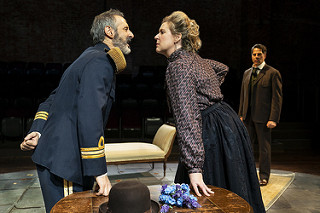* * *
In “Tootsie,” Michael Dorsey, who can’t get cast as an actor because of his well-deserved reputation for being aggressively earnest and impossible to work with, swears to his skeptical agent that he’s “in this business to make money.” The agent’s reply: “Really? The Harlem Theatre for the Blind? Strindberg in the Park?” To get the joke, you have to know that August Strindberg, Sweden’s greatest playwright, has an equally well-deserved reputation of his own for being depressing beyond belief. That’s the main reason why professional productions of Strindberg’s 60-odd plays, written between 1869 and 1909, are rare to the point of nonexistence in this country—I’ve reviewed two in the past 16 years—and why Classic Stage Company’s decision to mount his two best-known plays in repertory is important by definition. Neither staging is ideal, but both are effective, and if you haven’t seen much of his work, this is an admirable way to get your card punched.

“The Dance of Death,” the only one of Strindberg’s plays that gets done with any frequency in the U.S., is being performed in Conor McPherson’s 2012 version, a small-scale modern-English adaptation of the first half of the play from which three characters have been excised, thus making it much easier (and less costly) to stage. In addition to cutting “The Dance of Death” in half, Mr. McPherson has sharpened its humor to the point where it plays almost like a comedy, albeit one of a peculiarly acrid sort, the kind in which a long-married couple (Cassie Beck and Richard Topol) spend an evening slashing away at one another with vicious glee…
Victoria Clark, the director, is better known as one of the top musical-comedy singers in town. She has staged “The Dance of Death” in the round, italicizing its comic moments, and David L. Arsenault’s set and Tricia Barsamian’s costumes keep the production solidly rooted in the 19thcentury (the play was first performed in 1901). The performances are generally good…
I can’t quite say the same about “Mies Julie,” though not because of any inadequacies in the production, which is directed by Shariffa Ali with stingingly harsh vigor and acted with like impact by a cast led by Elise Kibler (who looks like she wandered in from a Tennessee Williams revival in which she played a naughty girl) and James Udom. The problem here is Yaël Farber’s 2012 adaptation of “Miss Julie,” which transplants Strindberg’s 1888 play to modern-day South Africa and covers it with a foot-thick frosting of up-to-the-second racial politics.
It’s not that you won’t get the point: Both versions tell the story of a young woman who lusts after one of her servants and is devastated by her desire. The catch is that “Miss Julie,” which was last seen in its original form on Broadway in 1962 (in Swedish, no less!), will likely be almost entirely unfamiliar to most of those who see this production….
* * *
Read the whole thing here.
